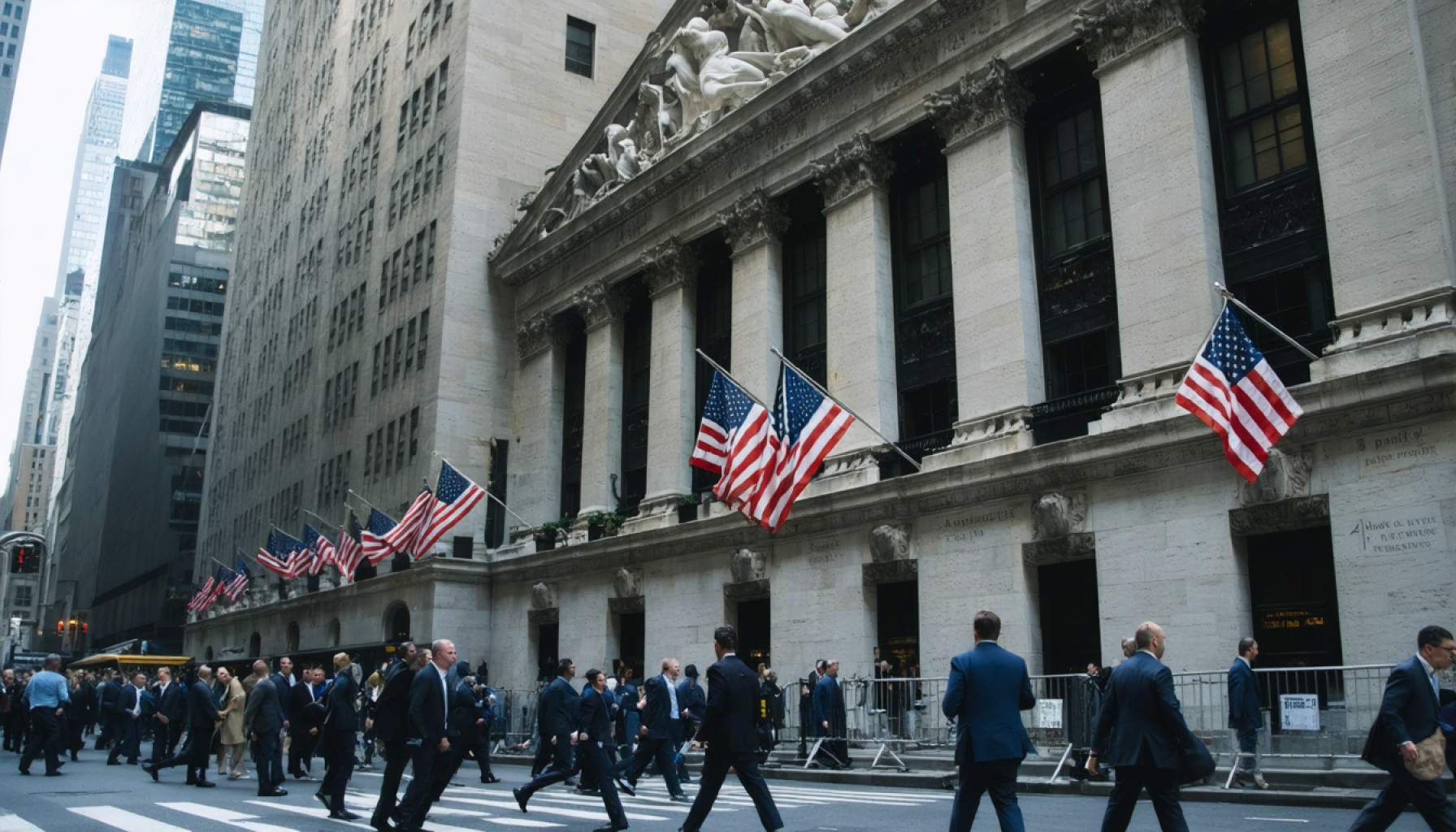
- The S&P 500 fell by 1.7%, signaling concerns over economic stability and business sentiment.
- The Dow Jones Industrial Average dropped 781 points, while the Nasdaq suffered a 2.2% decline.
- Fears over tariffs and shifting policies are affecting consumer sentiment and business optimism.
- Inflation worries due to potential tariffs are causing anxieties about rising import costs.
- Smaller companies and the Russell 2000 index experienced a 2.9% drop, highlighting domestic economic vulnerabilities.
- Amidst the downturn, American Water Works rose by 3.3%, demonstrating financial resilience.
- In times of uncertainty, finding steady investments proves crucial over speculative choices.
The bustling heart of New York’s financial district shuddered under a gloomier sky this past Friday, as the S&P 500 registered a disheartening 1.7% drop. This sudden downturn left many questioning the stability of an economy lauded for its resilience. A wave of weak reports swept through Wall Street, each like a gust of cold wind, suggesting that underlying concerns about President Trump’s policies might be casting a shadow over business sentiments.
Imagine the once vibrant pulse of U.S. business activity slowing to a crawl. The S&P Global report painted a grim picture of services sectors losing optimism, suffocated by fears of tariffs and governmental shifts. As these concerns crescendoed, the Dow Jones Industrial Average took a significant hit, plummeting 781 points. Meanwhile, the Nasdaq tumbled, marking a 2.2% loss, embodying the anxiety rippling through the tech sector.
The air was thick with speculation as consumer sentiment cooled, revealing a growing worry about inflated prices in the coming months. As potential tariffs loom, threatening to inflate import costs, the anticipation of increased expenses has gripped Americans, casting long shadows over household forecasts.
Amid this turbulence, smaller companies, often tethered more closely to domestic economic health, bore the brunt. The Russell 2000 index slipped by a disheartening 2.9%. Within the realm of major enterprises, tech giants and metal companies alike found themselves in similar predicaments, suffering notable declines.
But it wasn’t all bleak. Beacons of financial stability, like American Water Works, managed an admirable stand, rising 3.3%. This resilience underscores a valuable lesson: in turbulent times, seeking steady ground can be more vital than speculative leaps.
As the world watches this financial drama unfold, the narrative remains clear—uncertainty is the only certainty. Investors and everyday citizens alike must navigate this evolving landscape with a cautious, yet hopeful eye.
Is the Economy on Shaky Ground? Uncover the Hidden Dynamics Behind Market Fluctuations
Understanding Market Fluctuations: Causes and Insights
The recent downturn in the S&P 500, coupled with declines in the Dow Jones Industrial Average and Nasdaq, has sparked widespread concerns about the stability of the economy. While market volatility isn’t uncommon, understanding its root causes can provide valuable insights for investors and policymakers alike.
Causes of Recent Market Fluctuations
1. Policy Uncertainty: The wavering confidence in the financial markets is heavily influenced by the unpredictability of government policies, especially tariffs that could potentially increase import costs. Businesses find it challenging to plan future operations under such uncertain conditions.
2. Weak Economic Reports: Recent financial reports have indicated a slowdown in business activity, particularly in the services sector. This could be due to various factors, including global trade tensions and shifts in consumer spending.
3. Inflation Concerns: Rising prices and the anticipation of higher costs due to possible tariffs contribute to a decrease in consumer spending, affecting overall economic growth.
Real-World Use Cases
– Investment Diversification: As seen with the rise of American Water Works, sectors such as utilities may offer a safer haven amid turmoil. They typically provide steady returns due to constant demand, making them a reliable choice during economic uncertainty.
– Risk Management for Businesses: Companies can look into hedging strategies to protect against fluctuations in currency and commodity prices, ensuring more stability in unpredictable times.
Market Forecasts and Industry Trends
Analysts suggest that market volatility may persist as long as there is uncertainty about government policies and global economic conditions. However, sectors like technology continue to innovate, which bodes well for long-term growth despite short-term setbacks. Consumers should keep an eye on:
– Emerging Technologies: Companies investing in AI, cloud computing, and renewable energy are expected to drive future growth despite current market fluctuations.
– Sustainable Investments: With a growing focus on sustainability, businesses that invest in environmentally friendly practices are likely to see increased support and funding.
Pros & Cons Overview
Pros
– Opportunities for Growth: Market downturns provide opportunities to purchase undervalued stocks with potential for long-term gains.
– Learning Experience: Understanding the dynamics of market volatility can lead to more informed investing decisions in the future.
Cons
– Potential Losses: Short-term volatility can lead to significant financial losses for unprepared investors.
– Economic Uncertainty: Prolonged uncertainty can stifle economic growth and consumer confidence.
Security & Sustainability
Investors should consider companies with robust security measures in place, safeguarding them against potential threats. Sustainable businesses that prioritize environmental, social, and governance (ESG) factors are increasingly seen as resilient investments.
Actionable Recommendations
1. Diversify Your Portfolio: Consider allocating assets across various industries and sectors to mitigate risk.
2. Focus on Fundamentals: Invest in companies with strong financial health and solid business models, as they are more likely to withstand economic pressures.
3. Stay Informed: Regularly update yourself with economic news and expert analyses to make timely and informed investment decisions.
4. Evaluate Financial Goals: In light of market dynamics, reassess your financial objectives to align with current economic conditions.
For more financial insights and updates, visit Forbes or Bloomberg.
By understanding the causes and implications of market fluctuations, investors can make more strategic decisions, helping them navigate this uncertainty with confidence.



